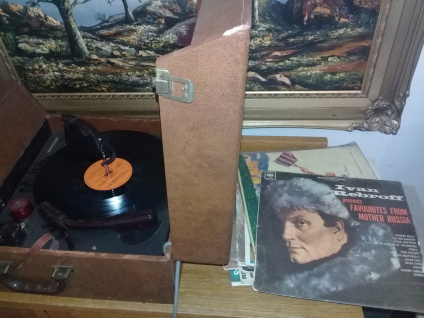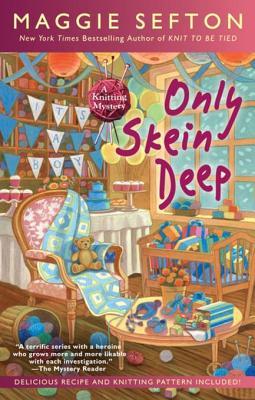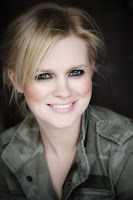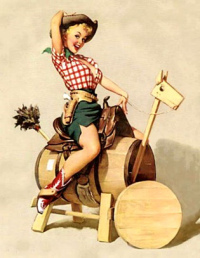
Gil Elvgren
Hey,
following the Muscleheaded Blog
can be quite a chore,
I understand that.
There’s some really weird stuff
on here, man.
So I try to mitigate the pain,
whenever possible,
…. with beautiful vintage pin up art.
Like creative writing,

Suzanne Meunier
a great piece of art can be said
to exist in three places…
in the heart of the artist,
in the mind of the viewer,
and upon the canvas/medium itself.
But interestingly enough,
none of these images are identical.
The artist always sees
his creation
from the perspective
of his inspiration —
— how well his creative expression
lived up to the original vision.
The viewer sees
and judges the work
from his own very distinctive
and individual set of preferences,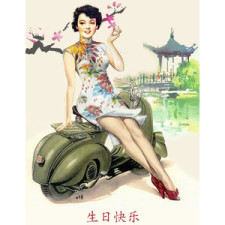
prejudices,
taste, and experience.
Much like a good work of poetry,
it is not all that relevant to its creator,
how the art is understood
by the individual viewer,
—– or to the viewer,
what the piece specifically
meant to the artist.
It is not necessary that there is a
meeting of minds between artist and art lover.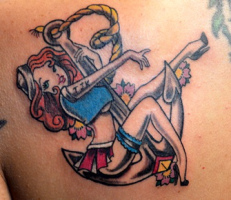
The image itself –
— on the canvas,
or on the film,
or on the drawing pad,
or even on the skin —
is simply a mass of colors,
contrasts, textures,
and shapes —
—which bridges the perspectives
of the artist with those of the viewer,
and creates a subjective experience in each.

Harry Ekman
No wonder there are so many
opinions on what is,
….. and what is not,
good art.
“Pin Ups” are an art form
that I am particularly fond of.
It is, of course,
a genre that isn’t
and cannot be strictly defined —
— although many see it
as a very narrow class related to
scantily clad, large breasted women
in provocative poses.
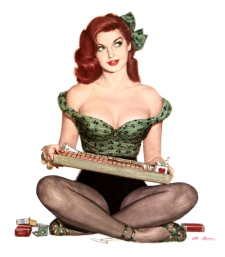
Al Moore
(Not that I have anything against
scantily clad, large breasted women
in provocative poses….. )
Actually,
I’m the last guy to knock
the whole idea of scantily clad women
of any breast size,
—- but that’s not all there is to it.
And I suppose that most pin-up fans
in the U.S. would define pin-ups,
as a purely American art form —
as characterized by the
work of artists like:
Gil Elvgren,
George Petty,

Coles Phillips
Rolf Armstrong,
Joyce Ballantyne,
Harry Ekman,
Zoe Mozert,
Earl Moran, etc–
……. and,
originating with pioneering artists
like:
Charles Dana Gibson,
Coles Phillips,
and J.C. Leyendecker.
The pin up form-
-in terms of tattooing-
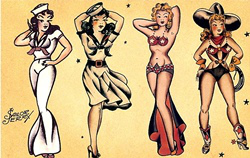
Sailor Jerry Collins
…. is actually considered part
of a genre called “American Traditional”-
typified by the works of artists like:
Sailor Jerry Collins,
Bob Shaw,
or Bert Grimm.
Pin-ups really get around, ya know.
In actual fact,
the first use of the term ‘pin up’
was in the British press, during the early 1940’s,

Fernande Barrey
…… and the practice of
hanging pictures and illustrations
of pretty girls in skimpy costumes
(or no costume at all)
started with English Tommies
during WW I.
This lovely French lady,
Miss Fernande Barrey,
graced the wall of many
a foxhole during the Great War,
…. and she can be rightfully
called the most popular pin up girl of the 20th century.
Yes,
even more popular than Bettie Page.
Her nudes,
in particular,
are today often categorized
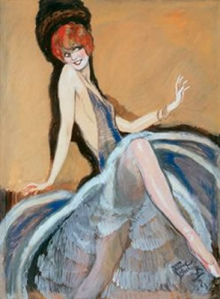
Jean-Gabriel Domergue
not under pin-ups, however,
but as “French Postcards”.
Still,
they were first and foremost
‘pin-ups’ in the most basic of ways.
So, personally,
I think the term ‘pin-up’
should be open for interpretation.
And, putting the whole ranges of
photographic, tattoo and
ultra-realist pin up art aside,
— that still leaves a wide variety
of styles in relation to painted
and illustrated forms.

Henry Clive
One cannot simply reject works of artists
like Raphael Kirchner and
Jean-Gabriel Domergue out of hand,
… because they didn’t fit a strict set
of parameters mostly related
to exaggerated perspective,
or because they weren’t American artists.
Other important European pioneers include:
British artists Aubrey Beardsley,
and David Wright,
Czech artist Alphonse Mucha,
Italian artist Achille Mauzan,
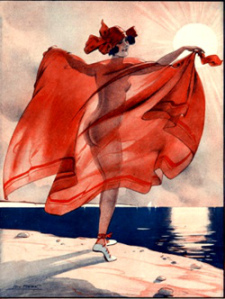
Leo Fontan
and French artists Leo Fontan,
and Xavier Sager.
As the 1930’s progressed,
pin-up styles advanced
and diversified overseas by artists like:
Takabatake Kasho,
Suzanne Meunier,
Victor Tchetchet
and Chéri Hérouard,
…… and in the United States by:
Haddon Sundblom,
Henry Clive,
Zoe Mozert
and Earl Moran.
World War II pushed the
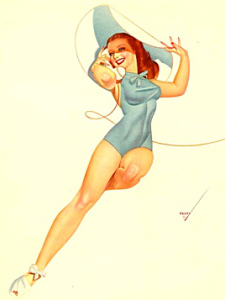
George Petty
envelope even further,
but slowly,
the art of George Petty and Gil Elvgren
became the ‘gold standard’
that other artists aspired to.
When the fifties broke,
even more commercial markets
for the “American” type of pin-up opened up–
Calendars,
pulp magazines,
advertising all were booming,
…… and the larger publishing houses
like Brown and Bigelow controlled both content and style.
This tended to restrict, to some extent,

Alberto Vargas
the creativity and innovativeness
of up and coming artists in the 1960’s .
If one looks at a 1960’s era Alberto Vargas,
for instance,
…. it’s not very different from the
pin-ups popular in the early 1930’s.
But, today, there has been a renaissance —
one might even say a revolution–
…….in the world of pin-up art.
Due to the ready availability
and open nature of the internet—
Artists are now free from the
traditional constraints of the
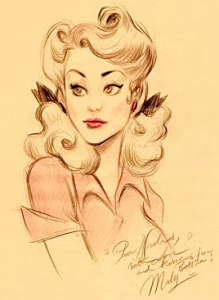
Maly Siri
old-order art marketplace.
Gone are the large publishing companies
enforcing their idea of art upon those
who wish to make a living creating
beautiful, sensual art.
Thus, gorgeous fresh and innovative works
of the pin up genre are being created
in all kinds of different styles
and mediums all around the world,
… by artists as diverse as:
Maly Siri,
Brett Parson,
Olivia de Berardinis,
Hajime Sorayama,
Tommy Tijeda,
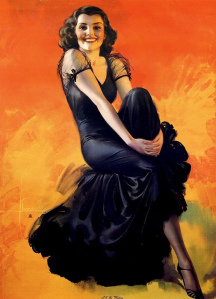
Rolf Armstrong
Shane Glines,
et al.
Because the essential aspect of pin up
isn’t so much a matter of technique or perspective,
….. as it is the ultimate projection
of feminine beauty and sensuality onto a medium —
Any medium.
Long live Pin-Up Art–
and the artists that create it !
.
Who’s your favorite Pin Up Artist ?
Let me know with a comment,
or a submission !
.
HOY !
.
 Alberto Vargas
Alberto Vargas


